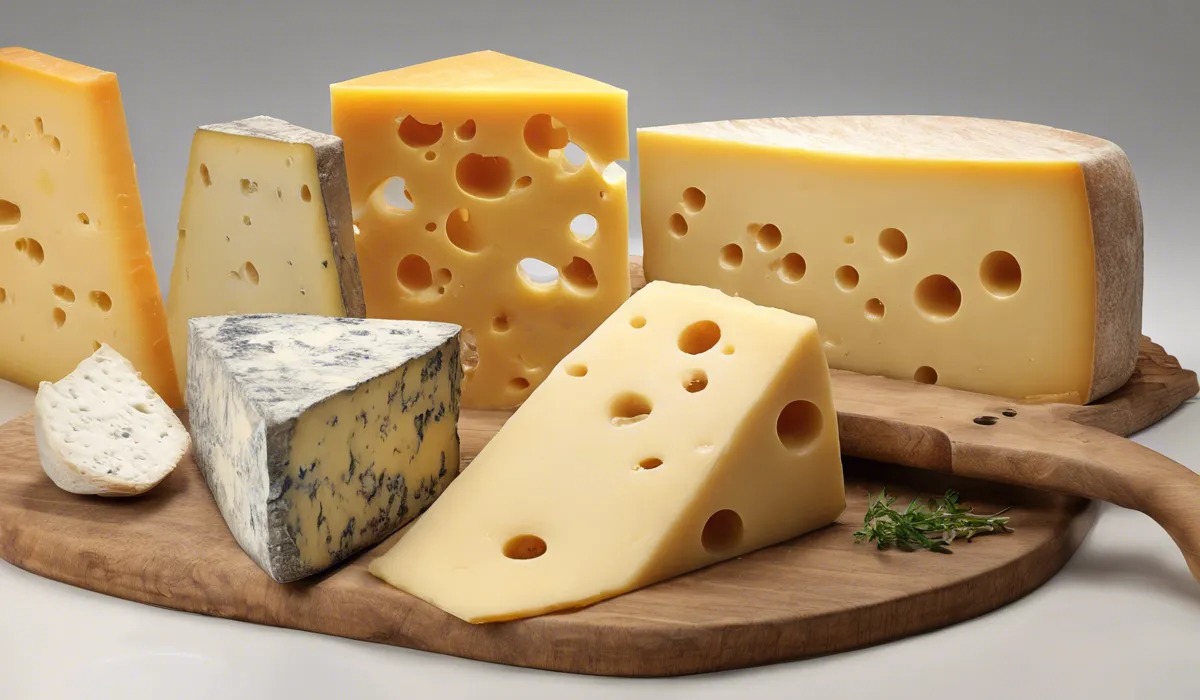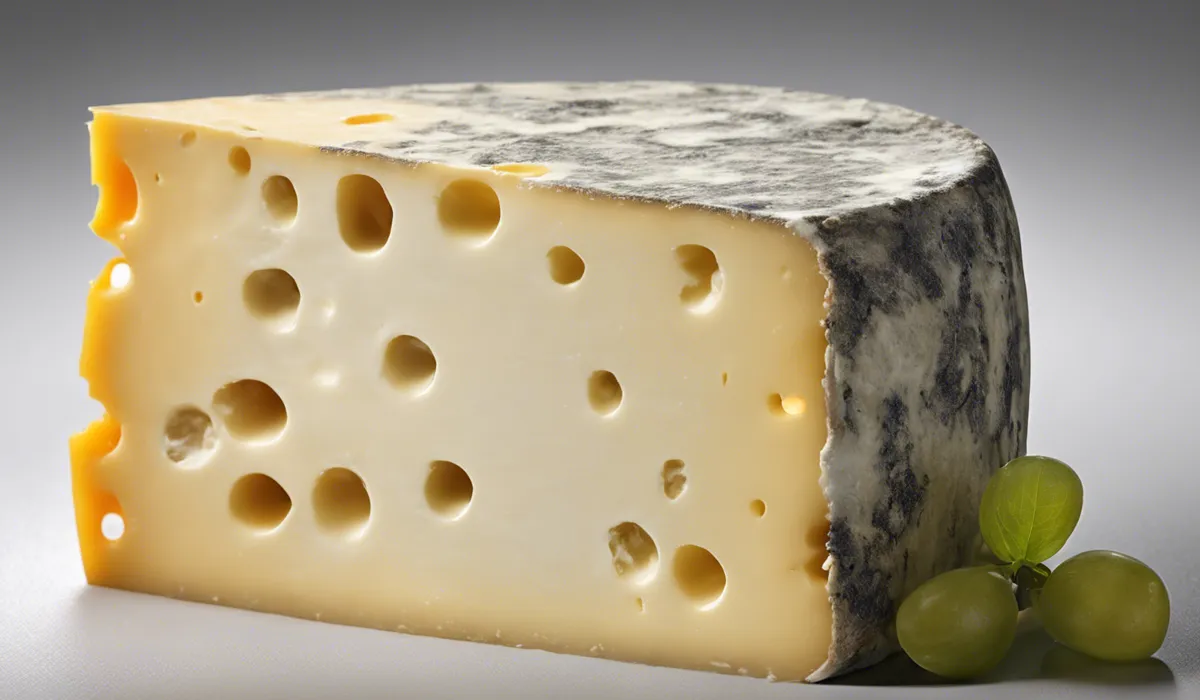Cheese is not made from mold but often uses bacteria or enzymes for curdling. Some cheeses have mold added for flavor and texture, like blue cheese. The mold in such cheeses is safe to eat and is integral to their character.
Cheese-Making Process and the Role of Mold

Understanding Cheese Coagulation
The journey to creating cheese begins with coagulation. This is where we add something special, like an enzyme or bacteria, to milk.
These helpers make the liquid milk start to clump together. This is an amazing change! The milk transforms into a solid mass we call curds and a liquid called whey.
The Magic of Curdling Milk
Next comes curdling. This step is where the milk turns into curds. The curds are the chunks that will become cheese.
We heat the milk and sometimes add something sour like lemon juice or vinegar. This makes the curds separate from the whey even more.
Pressing Curds into Cheese
After we have our curds, we press them. Pressing means squishing the curds together to make them into the shape of the cheese we want.
When we press the curds, we also squeeze out more whey. This makes the cheese firmer.
Beneficial Bacteria and Molds
In some cheeses, we add good bacteria and molds. These are not the kinds that make you sick.
They are special types that make the cheese taste good and give it a great texture. They can also help keep the cheese safe to eat.
Mold-Infused Cheeses
Some cheeses, like blue cheese, Brie, and Camembert, have mold in them on purpose. The mold gives these cheeses their unique flavors and looks.
The blue in blue cheese comes from mold! And the white rind on Brie and Camembert is also mold.
Good Mold vs. Bad Mold in Cheese
It’s important to know the difference between mold that’s supposed to be in cheese and mold that’s not. The mold in cheeses like Brie is safe and meant to be there.
But if you see mold on cheese that’s not supposed to have it, that’s spoilage, and it might not be safe to eat.
Types of Mold in Cheese Production

Molds for Blue Cheese
Blue cheeses get their taste from molds called Penicillium roquefortine and Penicillium glaucum.
These molds create the blue or green veins that you see in the cheese. They are perfectly safe to eat and are what make blue cheese so special.
Soft Cheese Molds
Brie and Camembert have a soft, white rind. This comes from a mold called Penicillium camembert.
It helps the cheese stay soft and gives it a nice flavor. This mold grows on the outside of the cheese and is part of what makes these cheeses special.
Surface Molds and Internal Molds
Some molds grow on the surface of the cheese, like on Brie and Camembert. Others are inside the cheese, like in blue cheese.
Surface molds help protect the cheese and give it flavor. Internal molds make the veins in blue cheese and also add to the taste.
Mold Safety in Cheese Production
When making cheese with mold, cheese makers follow strict rules. These rules make sure the mold is safe to eat.
The molds used in cheese are checked to be sure they are the right kind and that they won’t make people sick.
Health Implications and Consumption of Moldy Cheese

Nutritional Benefits of Mold in Cheese
Mold in cheese can be good for you. It can have things like vitamins and can help your body fight off bad bacteria. Eating cheese with mold in it can be a tasty way to get some extra nutrients.
Risks of the Wrong Mold
But not all molds are good to eat. Some can make you sick. It’s important to know which molds are safe.
If cheese has mold on it and it’s not supposed to, you should not eat it. This could be a sign that the cheese has gone bad.
Identifying Safe and Harmful Molds
Safe molds on cheese look like they belong there. They are usually in a pattern or have a certain color like the blue in blue cheese.
Harmful molds might look fuzzy and can be colors like black, pink, or green. These are signs that the cheese might be bad.
Storing Cheese Properly
To keep cheese fresh and safe, store it the right way. Cheese should be kept in the fridge. Some cheeses need to be wrapped tightly.
Others need to breathe a little. Always check the package for tips on how to store it best.
Handling Cheese to Avoid Unwanted Mold
When you handle cheese, make sure your hands are clean. Use clean knives and cutting boards, too.
This helps prevent bad molds from getting on the cheese. If you take care of your cheese, it will taste better and be safer to eat.
FAQs About Cheese and Mold
Is cheese made directly from mold?
No, cheese is not made directly from mold; it is primarily produced using bacteria or enzymes that curdle the milk. Mold may be added to certain cheeses for flavor and texture.
Are the molds used in cheese safe to eat?
Yes, the molds used in cheeses like blue cheese are safe to eat and contribute to the cheese’s unique flavor and texture.
What is the role of mold in cheese production?
Mold is added to some cheeses to develop specific characteristics, such as the veins in blue cheese, and it plays a role in ripening and flavor development.
Can all types of mold be used in cheese making?
No, only specific, safe-to-consume molds are used in cheese making, such as Penicillium roqueforti for blue cheeses.
Do all cheeses contain mold?
No, not all cheeses contain mold. Many cheeses are made without the addition of mold and are instead formed by the action of bacteria or enzymes.
Final Thoughts
Cheese production typically involves bacteria or enzymes rather than mold to curdle milk. However, specific varieties such as blue cheese are intentionally infused with mold for their unique flavor and texture.
The mold present in these cheeses is not only safe for consumption but also crucial to their distinctiveness.
